令和3年12月15日 水曜日号
“山紫水明 平成19年”
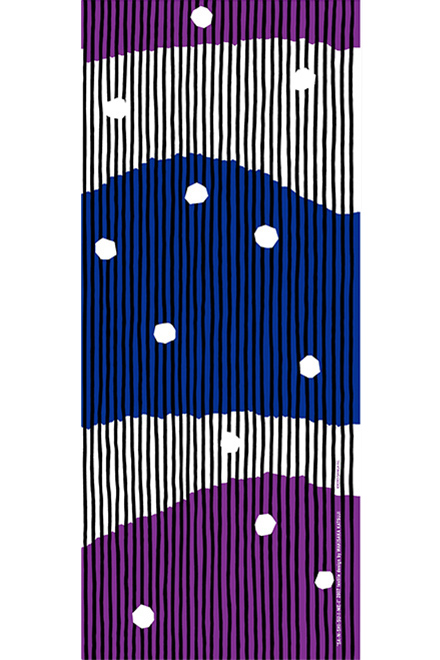
山は紫に、澄んだ水は清らかな山紫水明の地、京都。
このデザインは、京都サンガFCのために制作。
ランダムに散らばった12個の水玉は、
イレブンとサポーターを表しています。
(脇阪 克二)
Sanshisuimei (Scenic beauty) (2007, by Katsuji Wakisaka)
Kyoto is a city of great scenic beauty where
the mountains shine in purple during sunrise and sunset
and the rivers are crystal clear.
This design was created for Kyoto Sanga F.C.
The 12 polka dots scattered randomly
represented eleven players and supporters.
| English translation by Alison Chuang |
Paysage féerique (2007, par Katsuji Wakisaka)
Kyōto, paysage féerique où l’eau pure coule des montagnes violettes.
Ce design a été créé pour l’équipe de football de Kyoto Sanga FC.
12 pois disposés au hasard représentent joueurs et supporters.
| Traduction française par Jean-Baptiste Fauvel |
山紫水明 (2007, 脇阪 克二)
東山在日光中呈現紫色
鴨川流水清澈汎光
京都的自然風光可用「山紫水明」來概括
這幅紋樣是爲京都足球隊SANGA FC創作的
不規則排列的12個圓點
代表著11位球員和球迷
| 中譯 : 李 瀟瀟 |
→こちらのテキスタイルデザイン商品
(Textile products with this pattern)
令和3年12月11日 土曜日号
“庭石 平成18年”
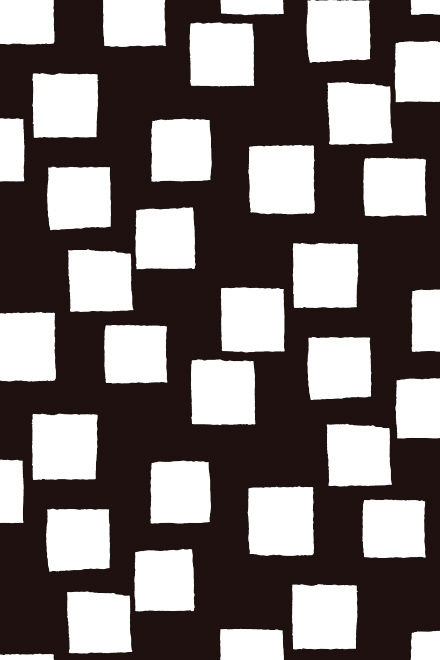
門をくぐると苔につつまれた敷石が不規則に
しかしある秩序を持って配置されている。
この絶妙な配置こそが日本らしい美しさだと思う。
(脇阪 克二)
Garden stones (2006, by Katsuji Wakisaka)
As I passed through the gate,
I saw paving stones covered with moss, irregularly placed in the garden.
However, they are arranged with a certain order.
I think this exquisite arrangement is the beauty of Japan.
| English translation by Alison Chuang |
Jardin sec (2006, par Katsuji Wakisaka)
De derrière la porte d’entrée, entouré de mousse,
apparait un jardin sec à la fois irrégulier et ordonné.
Pour moi, cette agencement si particulier est très
Représentatif de la beauté à la japonaise.
| Traduction française par Jean-Baptiste Fauvel |
庭石 (2006, 脇阪 克二)
進門後映入眼簾的是地上被青苔包裹的大石塊
看似不規則地排列
但又似乎存在著某種特定的秩序
庭石的絕妙排佈體現了日式美感
| 中譯 : 李 瀟瀟 |
→こちらのテキスタイルデザイン商品
(Textile products with this pattern)
令和3年12月08日 水曜日号
“ふんわり 平成23年”
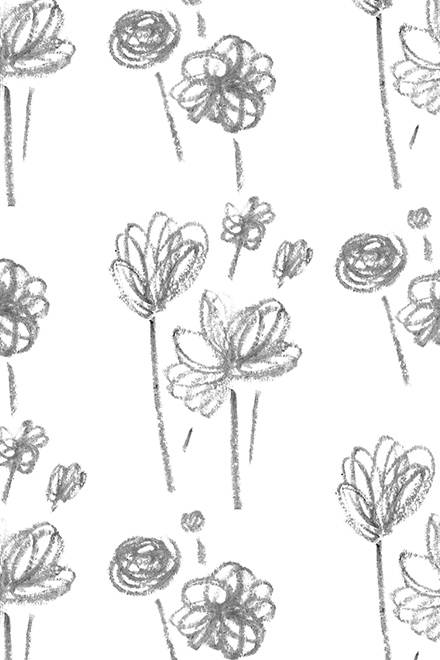
たんぽぽの羽根のように
ふーっと吹いたら飛んで
いきそうな花達。
ふんわり、ふわふわと
風にのってどこまでも
大空を飛んでいく。
ふんわり降り立ったところは
どんなところだろうか。
(脇阪 克二)
Slightly (2011, by Katsuji Wakisaka)
Like the wings of a dandelion,
these flowers seem to fly away
when they are blown.
Softly, slightly and fluffily,
they fly up into the sky,
wherever the wind takes them.
I wonder the destination
where they land softly.
| English translation by Karen Yiu |
Légèrement (2011, par Katsuji Wakisaka)
Comme les pétales de pissenlit,
Ces fleurs semblent sur le point
De s’envoler au vent.
Toutes légères et duveteuses,
Elles se font porter par le vent
Dans l’immensité du ciel.
Je me demande où elles
Finiront bien leurs chemins.
| Traduction française par Jean-Baptiste Fauvel |
輕柔 (2011, 脇阪 克二)
如蒲公英一般
輕輕一吹
就會飛走的花朵
隨風輕飄遠去
自由翺翔空中
不知道它們落下時
會在何地著陸呢
| 中譯 : 李 瀟瀟 |
→こちらのテキスタイルデザイン商品
(Textile products with this pattern)
令和3年12月04日 土曜日号
“雪花 平成18年”

ひらひらと舞い降りてくる雪は白く淡く一瞬にして消えていく。
実はそのひとつひとつの雪は花のように美しい雪結晶でできている。
(脇阪 克二)
Snowflakes (2006, by Katsuji Wakisaka)
The snow fluttering down in flakes are white and pale and disappear in an instant.
In fact, each snowflake is made up of beautiful crytals that look like flowers.
| English translation by Alison Chuang |
Flocon de neige (2006, par Katsuji Wakisaka)
La neige se transformant en flocons est blanche et pale,
Disparaissant en un instant.
En réalité, chaque flocon est un amas de magnifiques cristaux,
Qui ressemblent à des fleurs.
| Traduction française par Jean-Baptiste Fauvel |
雪花 (2006, 脇阪 克二)
雪花輕盈飄下
純白的淡雅的一瞬間消失不見
那些雪片的真實樣貌
是美如花般的雪之結晶
| 中譯 : 李 瀟瀟 |
令和3年12月01日 水曜日号
“原石 平成30年”

土から掘り出したばかりの
石のかたまり
ゴツゴツと荒々しく
このままでは何の価値もない
でも磨きをかけていくと
価値のあるものや
美しいものが出てくる。
人も原石のままでは特徴はない
しかしごしごしと磨きをかけていくと
思いがけない魅力的な人となってくる
(脇阪 克二)
Rough Stone (2018, by Katsuji Wakisaka)
Freshly digging out of the ground from the earth,
the stone is rugged and rough.
It has no value in its current state,
but if you polish it up, something valuable and
beautiful things will come out.
Humans are the same as stones,
have no characteristics when they are rugged and rough.
But if they scrub and polish themselves hard enough,
they will become an unexpectedly attractive person.
| English translation by Alison Chuang |
Brut (2018, par Katsuji Wakisaka)
Un amas de pierre
que je viens de déterrer du sol.
Brut de décoffrage,
elle n’a aucune valeur en l’état.
Mais, une fois que je la polis,
Elle se transforme en quelque chose
De beau et de valeur.
Les humains, comme les pierres bruts,
N’ont aucune caractéristique intrinsèque.
Cependant, en se polissant jours après jours,
Ils peuvent devenir de façon fortuite
Des personnes fascinantes.
| Traduction française par Jean-Baptiste Fauvel |
原石 (2018, 脇阪 克二)
從土中剛剛挖起的石塊,
粗糙不平,此時並沒有任何價值。
但是經過研磨拋光,
漸漸會出現具有價值和美麗的東西。
人和原石其實是相同的,
一開始沒有任何特色,
但是經過一點一點努力地打磨,
也會成為意想不到充滿魅力的人。
| 中譯 : 李 瀟瀟 |
→こちらのテキスタイルデザイン商品
(Textile products with this pattern)
令和3年11月27日 土曜日号
“花筏(はないかだ) 平成20年”
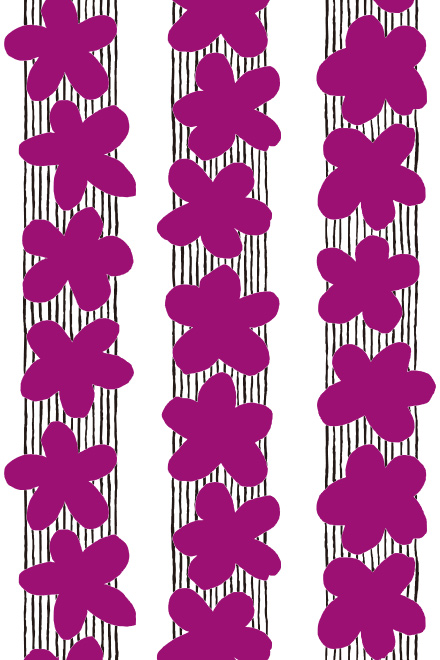
花が散って水面に浮かび
流れるのを筏に見立てる。
自然に溶けこんで遊びたわむれる
日本人の気持ちをよく表した言葉。
(脇阪 克二)
Hanaikada-Floating flowers(Dry landscape garden) (2008, by Katsuji Wakisaka)
Flowers falling on the surface of the water,
floating like a raft.
It is a playful word that expresses
how Japanese observe and blend with nature.
| English translation by Karen Yiu |
Hanaikada - Radeau de fleurs (2008, par Katsuji Wakisaka)
Les pétales de fleurs fanées qui se meuvent
Sur l’eau ressemblent à un radeau.
S’amuser en ne faisant qu’un avec la nature,
Un concept qui parle beaucoup au japonais.
| Traduction française par Jean-Baptiste Fauvel |
花筏(2008, 脇阪 克二)
櫻花凋落水中
仿佛在水面上鋪了一層花瓣做的筏木一般
這個意象表現了日本人對自然獨特的感受力
| 中譯 : 李 瀟瀟 |
令和3年11月25日 木曜日号
“狩野永徳 洛中洛外図屏風 写し 令和三年”
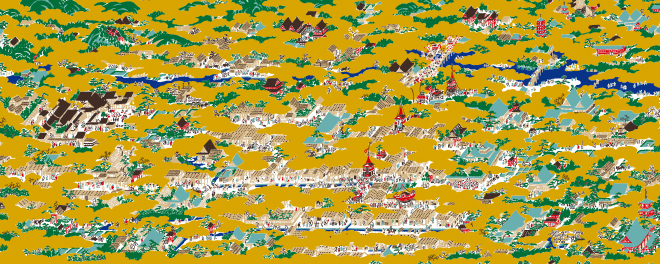

室町時代の京都の山や川
お寺に神社 お屋敷 民家や人々
衹園祭まで細かく描き込まれた
6曲の屏風
その全てを小さな手ぬぐいの
大きさに描いていく
いろんなものをはぶいて
大雑把なイメージだけを描く
全体が出来ると
これだけ省略したのに
京都の街のにぎわいがあふれ
人々の暮らしが
身近に感じられるてぬぐいになった
(脇阪 克二)
Eitoku Kano - In and Around the City of Kyoto - recreation(2021, by Katsuji Wakisaka)
From mountains and rivers of Kyoto
to temples, shrines, residences, houses,
and people in the Muromachi period,
even the Gion Festival had been depicted in detail.
The original painting was on a six-panel folding screen,
while I drew them all on a small terugui handkerchief.
Stripping away various objects,
only a rough image is drawn.
Even though I omitted so much,
it became a terugui that the bustle of the city of Kyoto overflew vividly
and let us feel close to the people's lives at that time.
| English translation by Alison Chuang |
Kano Eitoku - En et aux environs de la ville de Kyoto - Replica(2021, par Katsuji Wakisaka)
Des montagnes et des rivières de Kyoto, jusqu’aux temples, sanctuaires, résidences, demeures et population. Même le festival de Gion a été dépeint en détails.
L’oeuvre originale est réalisée sur un paravent à six panneaux tandis que moi je la dessinais sur un petit tenugui.
Enlevant divers détails, il ne restait qu’une simple esquisse.
Mais même si j’en ai beaucoup omis, c’est devenu une petite serviette qui nous fait ressentir l’agitation de la ville et nous rapproche un peu plus de la vie des gens de cette époque.
| Traduction française par Jean-Baptiste Fauvel |
狩野永德 洛中洛外屏風圖 再現(2021, 脇阪 克二)
「洛中洛外屏風圖」是一組描繪京都市區(洛中)及郊外(洛外)的六扇屏風畫。
室町時代京都的山河景色、寺廟神社、市井房屋、百姓生活,
甚至連祇園祭的場面也纖細地躍然畫上。
我將這幅巨作再現於一張小小手巾,
大膽捨去各種細節,
只保留原作的整體氛圍。
即便如此,最終完成的手巾圖案
將千年古都的熱鬧街景與當時人們的生活樣貌,
展現得生動而真實。
| 中譯 : 李 瀟瀟 |
→こちらのテキスタイルデザイン商品
(Textile products with this pattern)
令和3年11月24日 水曜日号
“枯山水 平成18年”
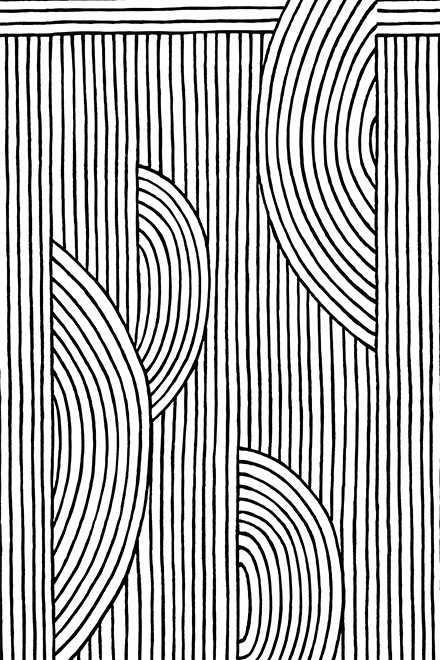
真白い砂の上を竹の熊手でゆっくり
しかし力強く刷け目をつけていく修行僧。
まっすぐにそしてまるく石をとりかこむように。
やがてそれは水の流れとなって
庭全体に広がっていく。
(脇阪 克二)
Karesansui (Dry landscape garden) (2006, by Katsuji Wakisaka)
The ascetic monk uses a bamboo rake giving appearance of water features among the white sand, slowly but with strength.
Continuously creating straight and curved pattern to resemble rivers passing through mountains that expressed by stones.
Eventually, the gravel river flows
spreading over the entire garden.
| English translation by Alison Chuang |
Jardin sec (2006, par Katsuji Wakisaka)
Lentement fait le moine sur le sable blanc avec un râteau en bambou, mais puissamment sur l’argile blanche laisse les traces.
Entoure la pierre droite et ronde.
Finalement devient courant d’eau et se répand sur tout le jardin.
| Traduction française par Jean-Baptiste Fauvel |
枯山水 (2006, 脇阪 克二)
以白砂和石頭展現自然之美的日本禪宗庭園。
修行僧用竹耙在純白砂上緩慢卻有力地,
創作出美麗紋路。
先作出直線,接著環繞石頭繪出圓弧,
讓白砂宛如流水般,
漸漸擴散至整個庭園。
| 中譯 : 莊 幃婷 |
令和3年11月20日 土曜日号
“土偶 令和2年”
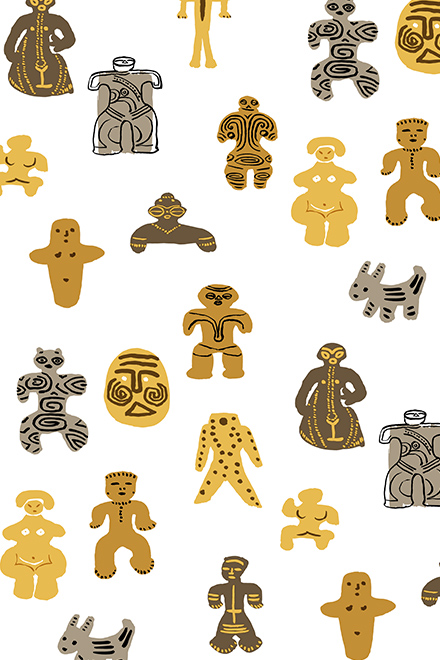
縄文時代
日本列島で作られていた土人形
人あるいは人型をした霊的な存在を
こねた土で造形し
素焼きで焼成したもの
女性型が多いがまれに男性も
素朴でたくましく強烈な存在感があり
どこかかわいい
人の原型を見るようで
強く魅かれるものがある
(脇阪 克二)
Dogu (2020, by Katsuji Wakisaka)
In the Jomon Period,
earthen figures are made in the Japanese archipelago.
Dogu are a person or a spiritual being in humanoid figurines.
They are molding of kneaded clay and and fired unglazed.
Mostly female, but rarely male.
They are simple, vigorously and have a strong presence,
somehow cute.
I am just like looking at the prototype of a human being.
There is something in Dogu that strongly fascinates me.
| English translation by Alison Chuang |
Statuette d’argile (2020, par Katsuji Wakisaka)
Pendant l’ère Jōmon, des statuette en terre étaient confectionnée à travers tout le Japon.
Faites à base d’argile sous forme humaine
Pour leur donner une entité spirituelle,
Elles étaient cuites puis vernissées.
Très souvent de formes féminines, il y en avait
Également avec des formes masculines très
Simples et robustes, les rendant mignonnes.
Aux allures d’hommes,
Elles sont extrêmement fascinantes.
| Traduction française par Jean-Baptiste Fauvel |
土偶 (2020, 脇阪 克二)
繩文時代,
在日本列島製作的人形土偶,
有人形也有作成人形如同神明和精靈的存在。
以黏土捏製成型,
最後用素燒完成的土偶,
以女性的形態居多,但也有少數男性。
素樸堅韌的強烈存在感,
還有一種說不出的可愛。
彷彿在觀看最原初的人類原型般,
讓人深深地受到吸引。
| 中譯 : 莊 幃婷 |
→こちらのテキスタイルデザイン商品
(Textile products with this pattern)
令和3年11月17日 水曜日号
“川明り 平成21年”
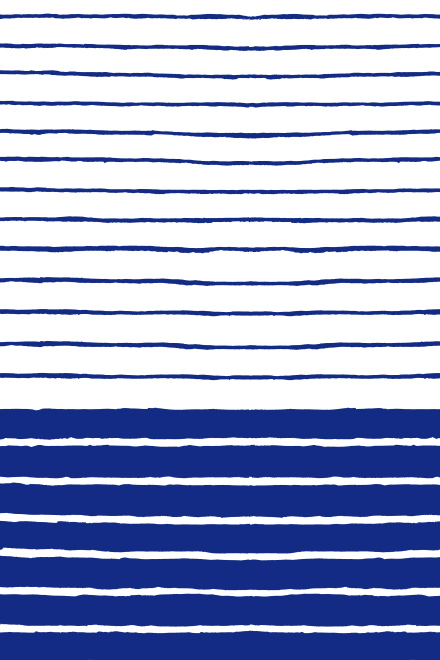
日が暮れて辺りが暗くなったころ
川の水面がほのかに明るさがただよっている。
暮らしの中の小さなことだけれど
それを見つけたことが
心を暖かくしてくれる。
(脇阪 克二)
Bright river (2009, by Katsuji Wakisaka)
When the sun has set and the area has become dark
The surface of the river is faintly bright.
It's a small thing in our life
But when I find it
that really warms my heart.
| English translation by Alison Chuang |
Lumière sur l’eau de jonc (2009, par Katsuji Wakisaka)
Lorsque le soleil se couche et que tout s’assombrit,
Une lumière floue dérive sur l’eau.
Il s’agit d’une toute petite chose de la vie
Mais de l’avoir trouvé me réchauffe le coeur.
| Traduction française par Jean-Baptiste Fauvel |
川明(2009, 脇阪 克二)
當天色漸漸暗下來
河床相反微微明亮起來
這一框日常生活中不起眼的景色
留意到它的人
心中會湧起一股暖意
| 中譯 : 李 瀟瀟 |
令和3年11月13日 土曜日号
“花筵(はなむしろ) 平成12年”
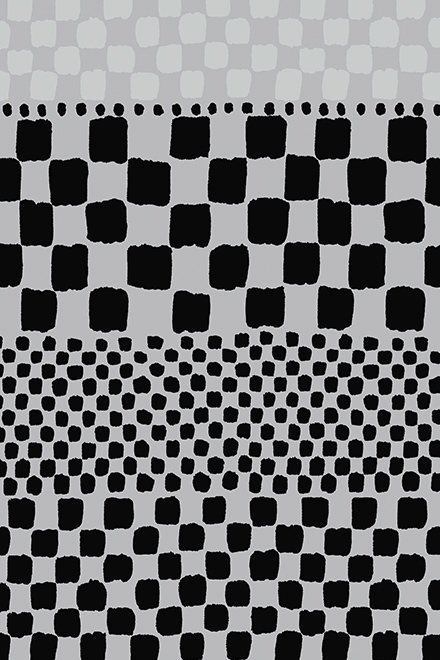
お花見などには広げてみんなで坐り、
花を見、食事をした。
暑いときには
その上に寝ころんだりといろんな場面で活躍した。
藺草で作られた自然素材なので肌触りがよく
気持いいものだ。
今もラグやカーペットとして
使われているすぐれものだ
(脇阪 克二)
Bulrush Mat (2000, by Katsuji Wakisaka)
We spread blurush mat and sit together
when it comes a cherry-blossom viewing party.
Seeing flowers and having some food.
When the weather is hot, we usually lie down on it.
And it can also be used in many different situations.
It is made from natural material rush and has a pleasant texture.
Today we still use this excellent item as a rug or carpet.
| English translation by Alison Chuang |
Natte de jonc (2000, par Katsuji Wakisaka)
Je suis allé manger avec tout le monde,
Assis à sur une natte de jonc,
À contempler les fleurs de cerisiers.
Lorsqu’il fait chaud, je me couche dessus,
Très utile dans de nombreux endroits.
Comme elle est fabriquée avec des matériaux naturelles,
Elle est très agréable au toucher.
Aujourd’hui, elle est même utilisée en intérieur,
Sous forme de tapis et de couvertures.
| Traduction française par JB&B |
花筵(2000, 脇阪 克二)
春天櫻花盛放時
人們鋪開燈心草製作的筵席
圍坐在一起賞花、野餐
到了夏天,愜意地躺在上面小睡
筵席使用天然素材,親膚涼爽
自古有多種用途
還可以做成地毯等
真是日常生活中的萬用好物!
| 中譯 : 李 瀟瀟 |
令和3年10月30日 土曜日号
“光琳 紅白梅図屏風 写し 令和三年”
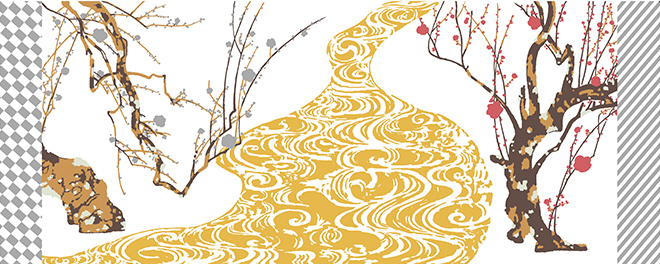

この有名な絵を写してみる
構図は全く同じで
色は何色かにしぼり
タッチは僕自身の感じで描く
意外と伸び伸び描くことが出来る
光琳を信頼して
身を任せてしまえるからだろう
出来上ってみると
光琳の絵なのだが
少し違った空気感がただよっている
これが写しの醍醐味だろうか
(脇阪 克二)
Ogata Korin - Red and White Plum Blossoms-recreation(2021, by Katsuji Wakisaka)
I'm trying to recreate this famous painting.
The composition is exactly the same.
The colors are limited to a few,
and the brushstrokes follow my own feeling.
It's surprisingly easy to paint in a relaxed way.
I think it's because I trust Korin and immerse myself in this drawing.
The finished work is a Korin's painting, but with a slightly different atmosphere.
Is this the ture charm of recreation?
| English translation by Alison Chuang |
Kōrin - Paravents de pruniers rouges et blancs - Replica(2021, par Katsuji Wakisaka)
J’ai tenté de reproduire cette oeuvre si connue.
De composition identique,
Je me suis limité à quelques couleurs
tout en y apposant ma propre griffe.
Étrangement, j’ai pu dessiné de façon libérée.
Serait-ce dû à la confiance que je porte en maitre Kōrin?
Une fois fini, il s’agit bien de l’oeuvre de Kōrin mais,
Il y a un je-ne-sais-quoi de différent.
S’agirait-il de la beauté du replica?
| Traduction française par Jean-Baptiste Fauvel |
尾形光琳 紅白梅圖屏風 再現(2021, 脇阪 克二)
我再現了著名的《紅白梅圖屏風》
構圖與原畫完全一致
配色精選了幾種顔色
筆觸按照我自己的風格
或許是因爲繪製時完全相信原作者尾形光琳
將身心投入到沉浸的狀態
最後詮釋出的作品意外地輕鬆而流暢
這幅《紅白梅圖屏風》表現出與原畫氛圍的細微差別
大概就是再現經典名作的有趣之處吧
| 中譯 : 李 瀟瀟 |
→こちらのテキスタイルデザイン商品
(Textile products with this pattern)
令和3年10月16日 土曜日号
“とえはたえ 令和3年”

とえはたえとは
十重二十重と書き
何重にも重なり合っている様子
あっち向いたりこっち向いたりしながら
輪っかが積み重なっている感じがかわいい
(脇阪 克二)
Multitude (2021, by Katsuji Wakisaka)
Toehatae(Multitude) is written as
"tenfold and twentyfold" in Kanji which means
the appearance of many overlapping layers.
I drew rings in different directions,
as well as piled them up to create this lovely pattern.
| English translation by Alison Chuang |
Multitude (2021, par Katsuji Wakisaka)
En japonais, le mot « multitude »
S’écrit « 10 fois et 20 fois »,
Semblant se chevaucher tant de fois
Ci et là
Un empilement d’anneaux tellement joli
| Traduction française par JB&B |
十重二十重 (2021, 脇阪 克二)
日文中的「とえはたえ」漢字寫為
十重二十重
有層次繁多、重重環繞的意涵
我畫出很多不同朝向的圈圈
層層疊疊地組合成這個可愛圖案
| 中譯 : 李 瀟瀟 |
→こちらのテキスタイルデザイン商品
(Textile products with this pattern)
令和3年10月13日 水曜日号
“茶利 令和3年”

あまり聞かない言葉だが
滑稽 おどけ 冗談などを意味する
この柄は作った僕も何を表現したのかわからない
茶利という未知の言葉が
ぴったりだと思う
(脇阪 克二)
Chari (2021, by Katsuji Wakisaka)
It's not a word we hear very often.
It means comical, funny or joking.
I don't know what I am trying to express with this pattern.
I think the unknown word "chari" fits it perfectly.
| English translation by Alison Chuang |
Chari (2021, par Katsuji Wakisaka)
C’est un mot que je n’entends pas souvent
Cela signifie faire des plaisanteries, des blagues
Même moi, je ne sais même pas ce que j’ai voulu représenter
Dans ce motif
De ce fait, ce mot si peu connu de « Chari »
Lui convient tout à fait.
| Traduction française par JB&B |
茶利 (2021, 脇阪 克二)
日文中「茶利」一詞並不常聽到
意思是滑稽、詼諧、逗趣
我創作了這個圖案
但也説不清具體想要表現什麽
只覺得用「茶利」這個詞彙命名
十分貼切
| 中譯 : 李 瀟瀟 |
→こちらのテキスタイルデザイン商品
(Textile products with this pattern)
令和3年10月09日 土曜日号
“夜菊 平成21年”
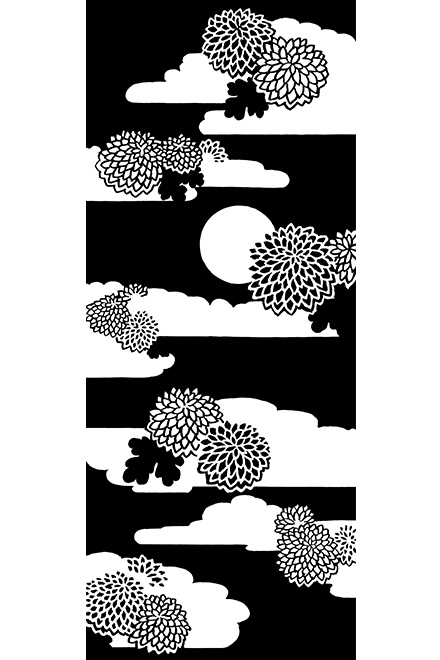
雲間から姿をあらわした、まん丸いお月さま。
その光に照らされて浮かび上がる白い菊の陰影が、
秋の夜の澄んだ空気を伝えてくる。
夜空の月と雲、そして菊の花。
日本情緒のひとつの姿がここにある。
(脇阪 克二)
Nighttime chrysanthemums (2009, by Katsuji Wakisaka)
The round moon appeared through the clouds.
When illuminated by the moonlight,
the shadows of the white chrysanthemums rise to the surface,
convey the clear air of an autumn night.
The moon, clouds, and chrysanthemum flowers in the night sky.
This is one form of Japanese atmosphere.
| English translation by Alison Chuang |
Chrysanthème de nuit (2009, par Katsuji Wakisaka)
À travers les nuages pointe la pleine lune.
L’ombre montante des chrysanthèmes blancs éclairées par la lumière de la lune
Nous apporte une grande bouffée d’air pur d’une nuit automnale.
Le ciel nocturne, la lune, les nuages et les fleurs de chrysanthèmes.
L’émotion japonaise se retrouve dans ce tableau.
| Traduction française par JB&B |
夜菊 (2009, 脇阪 克二)
圓圓的月亮從雲間顯現
月光投映出夜色中白菊陰影
這幅畫面能讓人感受到秋夜澄澈的空氣
夜空的月與雲,加上菊花
構成了日本獨特的美之精粹
| 中譯 : 莊 幃婷 |
- コメント
-
This is very nice! Hope to be use for the new cloths design.
- 最近書いた記事
- 関連記事
-
令和3年10月06日 水曜日号
“花格子 平成27年”
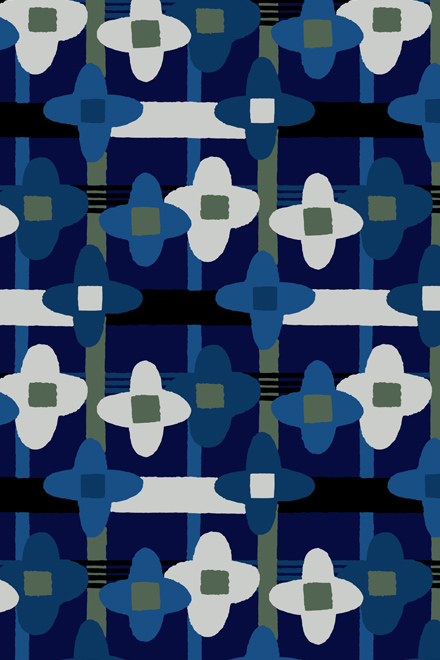
花と格子という
テキスタイルデザインでよく使われる
モチーフを組み合せたもの
花が星のようにキラキラ輝いているような
ポップなふんいきが出てきた
子供から大人まで親しめる柄かもしれない
(脇阪 克二)
Flower Lattice (2015, by Katsuji Wakisaka)
Flowers and lattice,
are often used in textile design.
I combine the two motifs together to make this pattern.
The flowers are shining like stars
and it creates pop atmosphere that
could delight children and adults.
| English translation by Alison Chuang |
Treillis de fleurs(2015, par Katsuji Wakisaka)
La forme en treillis et les motifs floraux
Sont des designs textiles très utilisés.
En les assemblant, on obtient un motif pop,
Avec les fleurs brillant comme des étoiles,
Qui ravira petits et grands.
| Traduction française par JB&B |
花格子 (2015, 脇阪 克二)
花與格子
是織紋設計中很常見的主題
我將兩者結合繪出這幅紋樣
花朵彷彿繁星般閃耀著光芒
這件作品不僅創造了一種流行氛圍
或許也能成為大人小孩都喜愛的印花圖案
| 中譯 : 莊 幃婷 |
→こちらのテキスタイルデザイン商品
(Textile products with this pattern)
令和3年10月01日 金曜日号
“菱川師宣 見返り美人図 写し 令和三年”
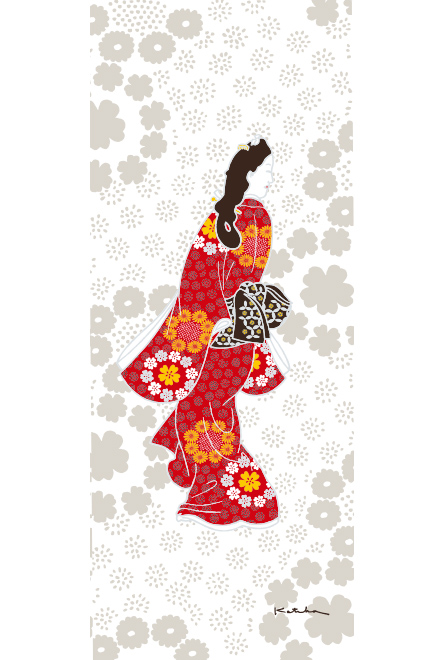

江戸時代の絵師 菱川師宣の
代表作である肉筆浮世絵
昭和23年に記念切手として発売され
この絵は広く大衆に知られることになった
着物を着て ふと振り向いた姿に
江戸時代の空気や風俗
人のあり方などが感じられる
(脇阪 克二)
Hishikawa Moronobu - Beauty Looking Back-recreation(2021, by Katsuji Wakisaka)
This is the masterpiece of Hishikawa Moronobu, a famous Ukiyo-e artist in Edo period.
It was issued as a commemorative Japanese stamp in 1948,
since then the picture became widely known to the public.
In the image of a woman wearing a kimono and suddenly looking back,
you can feel the atmosphere and people's lifestyle of the Edo period.
| English translation by Alison Chuang |
Moronobu Hishikawa - Beauté qui regarde en arrière - Réplica(2021, par Katsuji Wakisaka)
Chef d’oeuvre de l’artiste Moronobu Hishikawa,
Célèbre peintre spécialiste de l’Ukiyo-e pendant l’ère d’Edo.
Décliné en 1948 en timbre commémoratif au Japon,
Il est depuis largement connu du grand public.
Dans cette image d’une femme en kimono regardant soudain en arrière,
Nous pouvons ressentir l’atmosphère et le style particuliers de l’ère d’Edo.
| Traduction française par Jean-Baptiste Fauvel |
菱川師宣 美人回眸圖 再現(2021, 脇阪 克二)
《美人回眸圖》是江戶時代的浮世繪畫家菱川師宣的代表作
1948年這幅畫經日本郵局製作為紀念郵票發行而被世人所熟知
畫中身著和服的女性停足回望
其身姿讓我們充分領略江戶的時代氛圍及風俗文化
| 中譯 : 李 瀟瀟 |
→こちらのテキスタイルデザイン商品
(Textile products with this pattern)
令和3年09月29日 水曜日号
“小舞 平成28年”
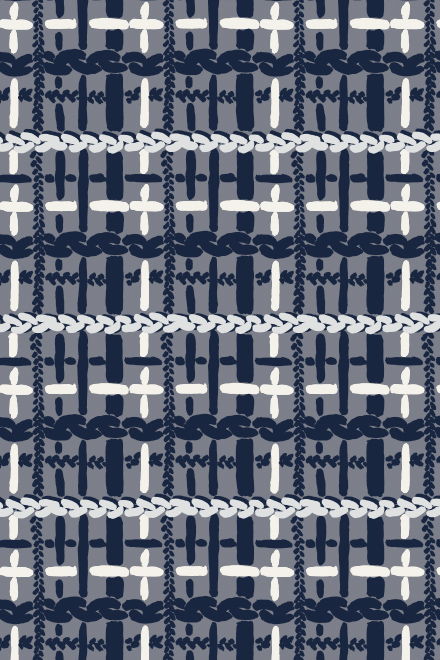
小舞という言葉は聞いたことがないと思う
日本建築の土壁の下地として
竹と縄で格子状に編んだもので
京都の方言だそうです
その上に土壁を塗り
しっくいなどで仕上げます
小舞は下地なので
出来上ると見えなくなるものですが
しっかりと壁を支えます
地味な存在ですが重要なもので
素朴で美しく
いとおしくさえ感じます
(脇阪 克二)
Komai (2016, by Katsuji Wakisaka)
I think you might have never heard the term "komai".
It is used as a base for clay walls in Japanese architecture.
It's made of bamboo and rope woven in a grid pattern.
And the name is from a dialect of Kyoto.
The wall is then finished with plaster.
The komai is the base of the wall,
so you can't see it when the wall is finished.
However, it supports the wall firmly.
It is a plain but important part of the wall,
while being unembellished, beautiful and even adorable.
| English translation by Alison Chuang |
Lattage de bambou (2016, par Katsuji Wakisaka)
Vous n’avez probablement jamais entendu le mot « lattage ».
Il s’agit de damiers de bambou tressés utilisés
Comme base pour les murs en terre des vieilles bâtisses japonaises.
Ce mot serait d’origine de la ville de Kyoto.
Ces damiers sont recouverts de terre, puis plâtrés.
Comme le lattage constitue la base du mur,
Il n’est pas très esthétique mais il le soutient solidement.
Bien que sobre, il est important, tout en étant simple, élégant et précieux.
| Traduction française par JB&B |
小舞 (2016, 脇阪 克二)
日文中有一個單字「小舞」,其涵義鮮爲人知
「小舞」是日本建築用語,也是京都方言
專指土牆下面由竹與繩子編製而成的格狀基底
用小舞打好牆底,接著再敷上土層,最後塗上灰漿
傳統日式土牆便完成了
小舞作爲牆基,雖不為人所見
卻默默支撐著牆體
如此不張揚卻至關重要的存在
讓人感受到一種樸素的美與可愛
| 中譯 : 李 瀟瀟 |
→こちらのテキスタイルデザイン商品
(Textile products with this pattern)
令和3年09月25日 土曜日号
“こっけい 平成23年”
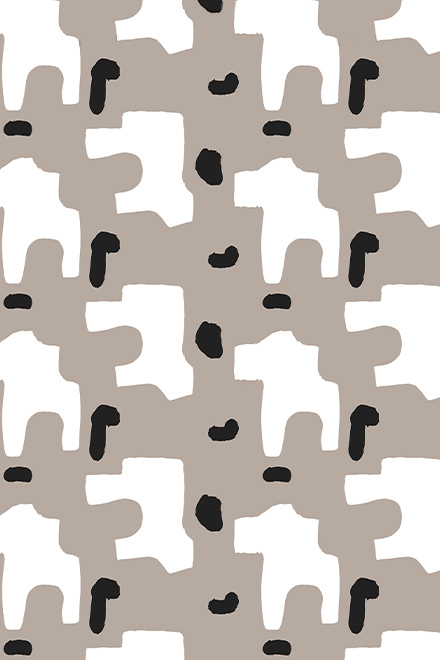
これは何の模様だろう
生き物みたいにも見えるがそうでもない
ジグソーパズルのようでもある
描いた時は特に何も考えず
筆のむくまま形をつくっていったら
こういうものが出来た
なぞの形だが
どこかこっけいさがただよっている
(脇阪 克二)
Humor (2011, by Katsuji Wakisaka)
What kind of pattern is this?
It looks like a living creature, but it's not.
It also looks like a jigsaw puzzle.
When I drew it, I just follow the drawing pen goes
without any definite purpose,
and this is what I got.
It's a mysterious shape
but there is a sense of humor in it.
| English translation by Alison Chuang |
Absurde (2011, par Katsuji Wakisaka)
À quoi cela ressemble-t-il?
Même pas à quelque chose de vivant
Aussi comme un puzzle,
quand je l’ai dessiné,
je n’ai pensé à rien en particulier
J’ai laissé aller mon pinceau
Et cette forme en est sortie
Forme mystérieuse,
Et quelque part aussi un peu absurde.
| Traduction française par JB&B |
幽默 (2011, 脇阪 克二)
這是什麽花紋呢?
像某種生物
又像拼圖
描繪這些形狀時
我未做任何構思
只是跟隨畫筆
最後得到了這個圖案
它無法被定義卻帶著一絲幽默詼諧
| 中譯 : 李 瀟瀟 |
→こちらのテキスタイルデザイン商品
(Textile products with this pattern)
令和3年09月22日 水曜日号
“華麗 令和2年”
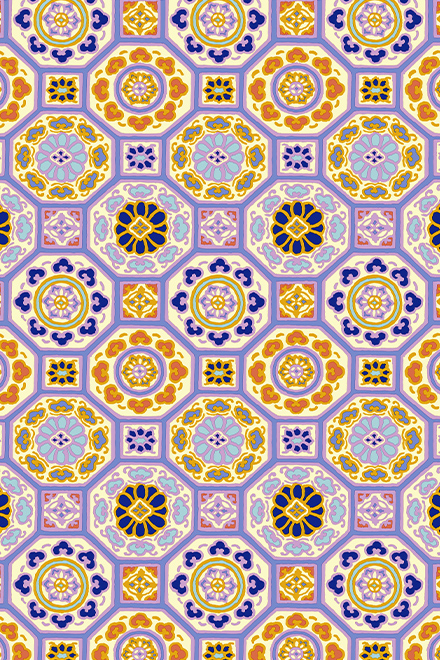
四角形と八角形で構成された中に
花を図案化して配置した
古典的な文様
古いものだが人の心をとらえる
根源的な何かがある
もともと織物の柄だが
プリントで表現するので
やわらかく重くならない様に
描いてみた
親しみやすく
華やかなふんいきを
出すことが出来たと思う
(脇阪 克二)
Gorgeous(2020, by Katsuji Wakisaka)
Making a design for flowers that are
arranged in a square and octagon.
This is a classic and ancient pattern,
but the fundamental beauty capture people's hearts.
It is originally a fabric pattern.
In order to express it by hand printing,
I try to draw it softer and not too heavy,
also approachable.
I believe it creates a gorgeous atmosphere.
| English translation by Alison Chuang |
Splendeur (2020, par Katsuji Wakisaka)
J’ai dessiné de façon stylistique une fleur
À partir d’un carré et d’un octogone,
Pour arriver à un motif traditionnel.
Si ancien et pourtant si captivant,
Une sorte de retour au source.
A l’origine un motif de tissu,
Je l’ai dessiné plus légèrement
Afin qu’il sorte au mieux en version imprimé.
Je pense être arrivé à un résultat
Familier et limpide.
| Traduction française par JB&B |
華麗 (2020, 脇阪 克二)
由四角形和八角形組成的畫面中
放入花紋圖案
構成這幅古典紋樣
雖然是古代傳留下來的樣式
卻有一種抓住人心的魔力
原本是傳統織物紋樣
為了用平面染印展現出它的美
我用輕柔筆觸將其描繪得親切又華麗
| 中譯 : 李 瀟瀟 |
→こちらのテキスタイルデザイン商品
(Textile products with this pattern)







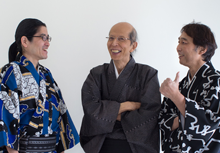

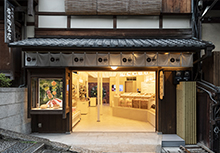

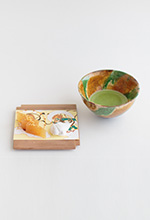
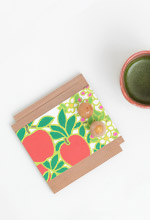
 お問い合わせ窓口
お問い合わせ窓口
若林社長が仰ってましたが、テキスタイルとネーミングのマッチが不思議というか、凄いというか・・。
まだまだ色々、テキスタイルデザイン、楽しみです。